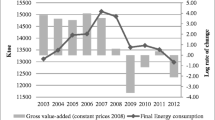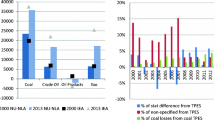Abstract
The world energy demand is increasing due to rapid growth in the global economy, industrialization, and urbanization. Pakistan is also confronted with increasing energy demand on one hand and is confronted with the challenge of energy demand-supply gap on the other hand. Since energy is the major driver for growth, it becomes important to investigate the trends of energy consumption in a country and the factors that are most affecting the changes in the use of energy. This particular study aims to investigate the use of energy by all the economic sectors of Pakistan during 2000–2012. The major contribution is the first time application of structural decomposition analysis (SDA) for energy usage along with using Input-Output data for the period of 2002–2012. The results show the fluctuation of the energy intensity of the sectors throughout the study period. Also, the overall effect of energy intensity is negative on energy consumption and it shows a negative contribution value of −80.90% for the study period. Furthermore, the focus on more energy-intensive products like cement, automobiles, iron, steel products and the increasing final demand of the economy contributes to the growth of energy consumption in Pakistan during 2000–2012.
Similar content being viewed by others
References
Hydrocarbon Development Institute of Pakistan, Pakistan energy yearbook 2015, Ministry of Petroleum and Natural Resources, Government of Pakistan, 2015.
Planning Commission of Pakistan, Annual Plan 2014–2015, Government of Pakistan, Ministry of Planning, Development and Reforms, Pakistan, 2014, 119.
UNDP, Sustainable energy for all: Rapid assessment gap analysis Pakistan, Islamabad, Pakistan, UNDP-Government of Pakistan, 2014.
Miller R and Blair P, Input-Output Analysis Foundations and Extensions, Cambridge University Press, Cambridge, 2009.
Chung W S, Tohno S, and Shim S Y, An estimation of energy and ghg emission intensity caused by energy consumption in Korea: An energy I-O Approach, Applied Energy, 2009, 86(10): 1902–1914.
Chen S and Chen B, Urban energy consumption: Different insights from energy flow analysis, input-output analysis and ecological network analysis, Applied Energy, 2015, 138: 99–107.
Hong J, Shen G Q, Guo S, et al., Energy use embodied in Chinaś construction industry: A multi-regional input-output analysis, Renewable and Sustainable Energy Reviews, 2016, 53: 1303–1312.
Morimoto Y, A note on weighted aggregation in input-output analysis, International Economic Review, 1971, 12(1): 138–143.
Ang B W, Decomposition analysis for policymaking in energy: Which is the preferred method?, Energy Policy, 2004, 32(9): 1131–1139.
Hoekstra R and Van den Bergh J C, Comparing structural decomposition analysis and index, Energy Economics, 2003, 25(1): 39–64.
Ma C and Stern D I, China’s changing energy intensity trend: A decomposition analysis, Energy Economics, 2008, 30(3): 1037–1053.
Rrmose P, Structural decomposition analysis sense and sensitivity, Paper Prepared for the 19th International Conference on Input-output Techniques 13–17 June 2011 in Alexandria, 2010.
Dietzenbacher E and Los B, Structural decomposition techniques: Sense and sensitivity, Economic Systems Research, 1998, 10(4): 307–324.
Leontief W W, The Structure of American Economy, 1919–1929: An Empirical Application of Equilibrium Analysis, Harvard University Press, Cambridge, MA, 1941.
Carter A P, Structural change in the American economy, Harvard Studies in Technology and Society, Harvard University Press, Cambridge, 1971.
Leontief W W and Ford D, Air Pollution and the Economic Structure: Empirical Results of Input-Output Computations, Harvard University, Cambridge, US, 1971.
Skolka J, Input-output structural decomposition analysis for Austria, Journal of Policy Modeling, 1989, 11(1): 45–66.
Rose A and Miernyk W, Input-output analysis: The first fifty years, Economic Systems Research, 1989, 1(2): 229–272.
Rose A and Chen C Y, Sources of change in energy use in the US economy, 1972–1982: A structural decomposition analysis, Resources and Energy, 1991, 13(1): 1–21.
Barker T, Sources of structural change for the UK service industries 1979–4, Economic Systems Research, 1990, 2(2): 173–184.
Martin R P and Holland D, Sources of output change in the US economy, Growth and Change, 1992, 23(4): 446–468.
Bekhet H A, Decomposition of Malaysian production structure input-output approach, International Business Research, 2009, 2(4): 129–139.
Liu A and Saal D S, Structural change in Apartheid-Era South Africa: 1975–1993, Economic Systems Research, 2001, 13(3): 235–257.
Roy S, Das T, and Chakraborty D, A study on the Indian information sector: An experiment with input-output techniques, Economic Systems Research, 2002, 14(2): 107–129.
US Congress, Office of technology assessment, energy use and the U.S. economy, OTA-BP-E-57, U.S. Government Printing Office, Washington, DC, USA, 1990.
Lin X and Polenske K R, Input-output anatomy of China’s energy use changes in the 1980s, Economic Systems Research, 1995, 7(1): 67–84.
Nie H and Kemp R, Why did energy intensity fluctuate during 2000–2009? A combination of index decomposition analysis and structural decomposition analysis, Energy for Sustainable Development, 2013, 17(5): 482–488.
Fisher-Vanden K, Jefferson G H, Liu H, et al., What is driving China’s decline in energy intensity?, Resource and Energy Economics, 2004, 26(1): 77–97.
Wu L, Kaneko S, and Matsuoka S, Driving forces behind the stagnancy of China’s energy-related CO2 emissions from 1996 to 1999: The relative importance of structural change, intensity change and scale change, Energy Policy, 2005, 33(3): 319–335.
Zha D, Zhou D, and Ding N, The contribution degree of sub-sectors to structure effect and intensity effects on industry energy intensity in China from 1993 to 2003, Renewable and Sustainable Energy Reviews, 2009, 13(4): 895–902.
Zeng L, Xu M, Liang S, et al., Revisiting drivers of energy intensity in China during 1997–2007: A structural decomposition analysis, Energy Policy, 2013, 67: 640–647.
Kagawa S and Inamura H, A structural decomposition of energy consumption based on a hybrid rectangular input-output framework: Japan’s case, Economic Systems Research, 2001, 13(4): 339–363.
Berndt E R and Wood D O, Technology, prices, and the derived demand for energy, The Review of Economics and Statistics, 1975, 57(3): 259–268.
Borges A M and Goulder L H, Decomposing the impact of higher energy prices on longterm growth, Chapter 8 in Scarf H E and Shoven J B, Applied General Equilibrium Analysis, 1984.
Okushima S and Tamura M, Identifying the sources of energy use change: Multiple calibration decomposition analysis and structural decomposition analysis, Structural Change and Economic Dynamics, 2011, 22(4): 313–326.
De Haan M, A structural decomposition analysis of pollution in the Netherlands, Economic Systems Research, 2001, 13(2): 181–196.
Seibel S, Decomposition analysis of carbon dioxide emission changes in Germany-conceptual framework and empirical results, Luxembourg: Office for Official Publications of the European Communities, European Communities, 2003.
Munksgaard J, Pedersen K A, and Wien M, Impact of household consumption on CO2 emissions, Energy Economics, 2000, 22(4): 423–440.
Wadeskog A, Palm V, and Sweden S, Structural decomposition of environmental accounts data — The Swedish case, Statistics Sweden, Eurostat Report, 2003.
Wang Y, Zhao H, Li L, et al., Carbon dioxide emission drivers for a typical metropolis using input-output structural decomposition analysis, Energy Policy, 2013, 58: 312–318.
Chong W H B, Guan D, and Guthrie P, Comparative analysis of carbonization drivers in China’s megacities, Journal of Industrial Ecology, 2012, 16(4): 564–575.
Lim H J, Yoo S H, and Kwak S J, Industrial CO2 emissions from energy use in Korea: A structural decomposition analysis, Energy Policy, 2009, 37(2): 686–698.
Su B and Ang B, Structural decomposition analysis applied to energy and emissions: Some methodological developments, Energy Economics, 2012, 34(1): 177–188.
Zhao X, Ma C, and Hong D, Why did China’s energy intensity increase during 1998–2006: Decomposition and policy analysis, Energy Policy, 2010, 38(3): 1379–1388.
Andreoni V and Galmarinic S, Decoupling economic growth from carbon dioxide emissions: A decomposition analysis of Italian energy consumption, Energy, 2012, 44(1): 682–691.
Mi Z, Zheng J, Meng J, et al., China’s energy consumption in the new normal, Earth Future, 2018, 6: 1007–1016.
Wang H, Ang B W, and Su B, Assessing drivers of economy-wide energy use and emissions: IDA versus SDA, Energy Policy, 2017, 107: 585–599.
Romn-Collado R and Colinet M J, Is energy efficiency a driver or an inhibitor of energy consumption changes in Spain? Two decomposition approaches, Energy Policy, 2018, 115: 409–417.
Liu X J, Liao S M, Rao Z H, et al., A process-level hierarchical structural decomposition analysis (SDA) of energy consumption in an integrated steel plant, Journal of Central South University, 2017, 24(2): 402–412.
Ahmad M, Sectoral price changes in Pakistan: An input-output analysis, Pakistan Economic and Social Review, Vols. Summer, 1991, 29(1): 57–75.
Siddiqui R and Iqbal Z, Social accounting matrix of Pakistan for 1989–90, Pakistan Institute of Development Economics, Report No. 171, Islamabad, Pakistan, 1999.
Dorosh P, Niazi M K, and Nazli H, A social accounting matrix for Pakistan, 2001–02: Methodology and results, Islamabad, Pakistan, PIDE-Working Papers 2006: 9, Pakistan Institute of Development Economics, 2006a.
Dorosh P, Niazi M K, and Nazli H, A social accounting matrix for Pakistan, 2001–02: Methodology and results, Finance Working Papers 22187, East Asian Bureau of Economic Research, Crawford School of Public Policy at the Australian National University, Canberra, Australia, 2006b.
Abbas A, Yang M, Yousaf K, et al., Comparative analysis of energy use efficieny in food grain production systems of Pakistan, Fresenius Environmental Bulletin, 2018, 27(2): 1053–1059.
Aqeel A and Butt M S, The relationship between energy consumption and economic growth in Pakistan, Asia-Pacific Development Journal, 2001, 8(2): 101–110.
Sindhu M A, Babar Z A, and Abbas A, Analyzing the relationship of energy consumption, consumer expenditures and economic growth: A case study of Pakistan, Journal of Research in Social Sciences, 2018, 6(1): 2305–6533.
Lee C C and Chang C P, Energy consumption and economic growth in Asian economies: A more comprehensive analysis using panel data, Resource and Energy Economics, 2005, 30: 50–65.
PBS, Pakistan Bureau of Statistics, 2018. [Online]. Available: http://www.pbs.gov.pk/content/when-were-inputoutput-tables-compiled-last-time. [Accessed 2 December 2018].
Debowicz D, Dorosh P, Haider H, et al., A 2007–08 social accounting matrix for Pakistan, Pakistan Strategy Support Program (PSSP) Working Paper No. 001, Available at SSRN: https://ssrn.com/abstract=2161402 or https://doi.org/10.2139/ssrn.2161402, 2012.
Eurostat, Eurostat manual of supply, use and input-output tables (2008 edition), Office for Official Publications of the European Communities, Luxembourg, 2018.
Ministry of Finance, Economic survey of Pakistan 2000–01, Government of Pakistan: Islamabad, Pakistan, 2000.
Ministry of Finance, Economic survey of Pakistan 2001–02, Government of Pakistan: Islamabad, Pakistan, 2001.
Ministry of Finance, Economic survey of Pakistan 2009–10, Government of Pakistan: Islamabad, Pakistan, 2009.
Ministry of Finance, Economic survey of Pakistan 2010–11, Government of Pakistan: Islamabad, Pakistan, 2010.
Ministry of Finance, Economic Survey of Pakistan 2011–12, Government of Pakistan: Islamabad, Pakistan, 2011.
Khalid M A and Ali Y, Analysing economic impact on interdependent infrastructure after flood: Pakistan a case in point, Environmental Hazards, 2019, 18(2): 111–126.
Rose A and Casler S, Input-output structural decomposition analysis: A critical appraisal, Economic Systems Research, 1996, 8(1): 33–62.
Zhang Y, Structural decomposition analysis of sources of decarbonizing economic development in China; 1992–2006, Ecological Economics, 2009, 68(8–9): 2399–2405.
Zhang Y, Supply-side structural effect on carbon emissions in China, Energy Economics, 2010, 32(1): 186–193.
Peng Y and Shi C, Determinants of carbon emissions growth in China: A structural decomposition analysis, Energy Procedia, 2011, 5: 169–175.
Author information
Authors and Affiliations
Corresponding authors
Additional information
This paper was recommended for publication by Editor YANG Cuihong.
Rights and permissions
About this article
Cite this article
Ali, Y., Saleem, S.B. & Sabir, M. Structural Decomposition Analysis to Investigate the Changes in Energy Consumption in Pakistan. J Syst Sci Complex 33, 1497–1515 (2020). https://doi.org/10.1007/s11424-020-8148-6
Received:
Revised:
Published:
Issue Date:
DOI: https://doi.org/10.1007/s11424-020-8148-6




